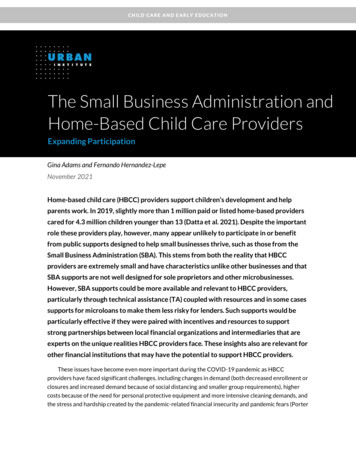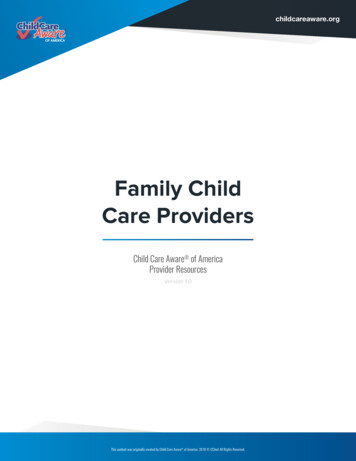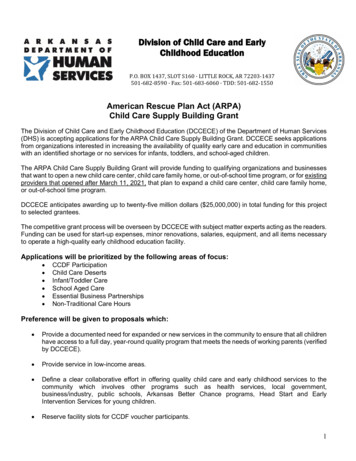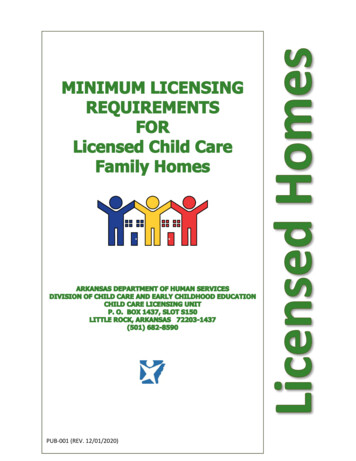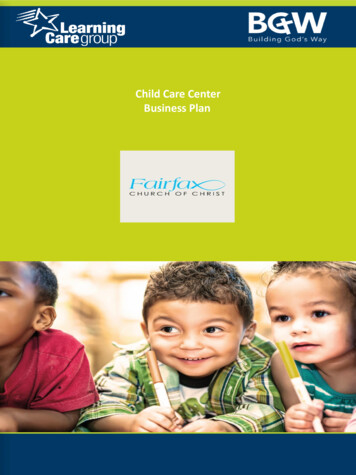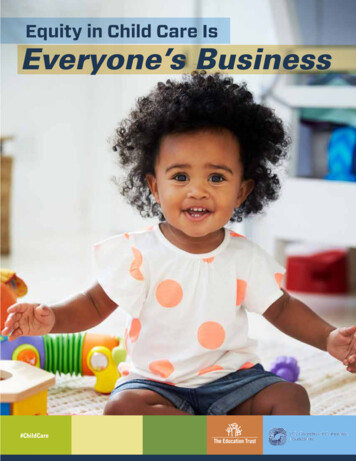
Transcription
Equity in Child Care IsEveryone’s Business#ChildCare
#ChildCare2CHILD CARE IS EVERYONE’S BUSINESS The Education Trust & U.S. Chamber of Commerce Foundation November 2021
#ChildCareTABLE OF CONTENTSEXECUTIVE SUMMARY. 4HOW COVID-19 IS AFFECTING CHILD CARE PROVIDERS. 7COVID-19’S IMPACT ON SMALL BUSINESSES. 8THE EDUCATION TRUST AND THE U.S. CHAMBER OF COMMERCEFOUNDATION JOINED FORCES TO IDENTIFY OPPORTUNITIES FOR ACTION. 9WHAT WE HEARD FROM CHILD CARE PROVIDERS ANDSTATE AND LOCAL CHAMBERS. 13CHILD CARE PROVIDERS IDENTIFIED 4 KEY CHALLENGE AREAS. 28FIVE WAYS STATE AND LOCAL CHAMBERS CAN SUPPORTWORKING FAMILIES BY SUPPORTING FEMALE PROVIDERS OF COLOR. 29ACKNOWLEDGMENTS. 30ENDNOTES. 31
Executive SummaryEquity in Child Care IsEveryone’s BusinessAUTHORS:CARRIE GILLISPIE, Senior P-12 Research Associate, The Education TrustCAITLIN CODELLA, Vice President, Policy and Programs, U.S. Chamber of Commerce FoundationAARON MERCHEN, Director, Policy & Programs, Early Childhood Education, U.S. Chamber of Commerce FoundationJOSEPH DAVIS, Senior Manager, Communications, U.S. Chamber of Commerce FoundationASHLEY CAPPO, Manager, Operations and Programs, U.S. Chamber of Commerce FoundationABOUT THIS REPORTThe COVID-19 crisis has not only exacerbated existing inequities in child care access for families, but hasalso decimated the finances of child care providers, many of whom are women of color already economicallydisadvantaged by systemic racism and sexism. State and local chambers of commerce are uniquely positioned tooffer urgently needed small business resources to child care providers, while also acting as powerful connectorsamong community leaders interested in supporting families with young children. The Education Trust and the U.S.Chamber of Commerce Foundation interviewed child care providers and state and local chamber leaders across theU.S. to identify opportunities for supporting working families with young children by supporting female providersof color. Many child care providers told us that amid the COVID-19 crisis, they have faced funding challenges,safety and health concerns, and barriers to talent acquisition and professional development. Several providersreported that racial and gender bias has posed challenges within their local business community. Many said theyfelt less supported than other businesses due to their race. State and local chamber leaders noted that they andtheir business members are facing several challenges during the pandemic related to child care and outlinedseveral ways that state and local chambers could support providers of color and help align the needs and servicesof providers with those of their communities. This report describes these challenges and opportunities and offersrecommendations for how state and local chambers of commerce can support working families by supportingfemale providers of color.4CHILD CARE IS EVERYONE’S BUSINESS The Education Trust & U.S. Chamber of Commerce Foundation November 2021
Executive SummaryFIVE WAYSSTATE AND LOCAL CHAMBERS CAN SUPPORT WORKINGFAMILIES BY SUPPORTING FEMALE PROVIDERS OF COLORBY SUPPORTING THE PROVIDERS WHO CARE FOR OUR YOUNGEST LEARNERS, STATE AND LOCALCHAMBERS CAN, IN TURN, SUPPORT WORKING FAMILIES AND STRENGTHEN THE WORKFORCE ASWE EMERGE FROM THE COVID-19 CRISIS.State and local chambers should begin by seeking input from local female providers of color about the challengesthey are facing, the supports they need, and the programs they are offering, while employers can collect informationabout their employees’ child care needs and preferences. State and local chambers can then use the following fivestrategies, uncovered in our interviews, to provide critical support that will strengthen business communities, workingfamilies, and our youngest learners:SHARE RESOURCES ANDINFORMATION with providers aboutfunding opportunities, health insurance,and COVID-19-related health and safetyresources for small businesses. Stateand local chambers frequently sharethese types of resources with local smallbusinesses, and providers are oftensearching for such resources but havedifficulty finding them.OFFER NETWORKING AND MARKETINGOPPORTUNITIES for providers andemployers. State and local chambers cancreate opportunities for providers to connectwith chamber members and communityleaders, such as those from local financialinstitutions, business advisers, andcommunity members offering professionaldevelopment opportunities, higher educationresources, and marketing and growthstrategy supports.STRENGTHEN DIVERSITY, EQUITY,AND INCLUSION INITIATIVES, includingleadership and professional developmentopportunities for female providers of color.State and local chambers can proactivelyinvite female providers of color to join theirorganizations and other networks. They canprovide information about business coachingand mentorship programs specifically designedto support small businesses owned by womenand people of color.LIST CHILD CARE RESOURCES AND REFERRALINFORMATION on existing state and localchamber websites to better connect child caresupply with demand. State and local chamberwebsites often offer a multitude of resources forthe local business community. Chamber leaderscan help to align child care supply and demand bylisting local providers, availability, and services onthese websites, including specialized programs fornontraditional work schedules, so employers andfamilies can more easily find child care programsthat meet their needs and preferences.COMMUNICATE CHILD CARE NEEDS TO STATE AND LOCAL REPRESENTATIVES. State and localchambers can advocate for policies that support child care providers, parents and, ultimately, the childrenin their communities by giving them a strong start. Female providers of color can join chamber members inadvocating for policies that will boost access to high-quality child care that all children and families deserve.CHILD CARE IS EVERYONE’S BUSINESS The Education Trust & U.S. Chamber of Commerce Foundation November 202155
#ChildCareEquity in Child Care IsEveryone’s BusinessAUTHORS:CARRIE GILLISPIE, Senior P-12 Research Associate, The Education TrustCAITLIN CODELLA, Vice President, Policy and Programs, U.S. Chamber of Commerce FoundationAARON MERCHEN, Director, Policy & Programs, Early Childhood Education, U.S. Chamber of Commerce FoundationJOSEPH DAVIS, Senior Manager, Communications, U.S. Chamber of Commerce FoundationASHLEY CAPPO, Manager, Operations and Programs, U.S. Chamber of Commerce FoundationTHE EDUCATION TRUST AND THE U.S. CHAMBER OF COMMERCE FOUNDATION INTERVIEWED CHILD CAREPROVIDERS AND STATE AND LOCAL CHAMBER LEADERS ACROSS THE U.S. TO IDENTIFY OPPORTUNITIES FORSUPPORTING WORKING FAMILIES WITH YOUNG CHILDREN BY SUPPORTING FEMALE PROVIDERS OF COLOR.Families across the country rely on high-quality child care programs, so that children can learn while parents work.Before the pandemic, many families — especially Black and Latino families, families with low and middle incomes,and families in rural areas — had far too little access to high-quality child care, making it challenging for them tostay in the workforce and make ends meet while accessing safe and nurturing learning environments for their youngchildren.1 The COVID-19 pandemic has only exacerbated this challenge, as scores of child care programs have closed,often permanently, across the country.2 This crisis has forced working parents — particularly women, parents of colorand parents who cannot work from home — to leave the workforce or scramble to find alternative child care throughrelatives or unlicensed providers.3 As our nation emerges from the COVID-19 crisis, the shortage of child care providerscould have cascading effects on children throughout their early elementary school years, parents — especiallyworking mothers — struggling to re-enter the workforce or advance their careers, child care costs, which are risingas a result of recent child care program closures, as well as the broader economy. And unlike K-12 public schools,in which all children are guaranteed attendance, there is no assurance that child care programs — much less highquality ones — will have a spot for every child who needs one when it is safe to return to in-person learning. In fact,many parents wonder: “Will there be a program to go back to at all?”As our nation emerges from the COVID-19 pandemic, many parents wonder:“Will there be a program to go back to at all?6CHILD CARE IS EVERYONE’S BUSINESS The Education Trust & U.S. Chamber of Commerce Foundation November 2021
#ChildCareHOW COVID-19 IS AFFECTING CHILD CARE PROVIDERSThe COVID-19 crisis has not only exacerbated existing inequities in child care access for families, buthas also decimated the finances of child care providers, about 40% of whom are people of color alreadyeconomically disadvantaged by systemic racism.4 In December 2020, 25% of child care centers and 33%of family child care homes reported that if their enrollment did not increase, and if they did not receivesufficient funding, they would be forced to close within three months. Among child care programs owned bypeople of color, that number increased to 51%. This may also partially explain the especially high job lossrates among Black and Latina women compared to other Americans.5 In March 2021, Congress passed theAmerican Rescue Plan, which provides 39 billion in child care relief funds; combined with earlier pandemicrelief funding for child care, this brings the total amount of child care relief funding to 50 billion. Thesestabilization funds may provide temporary relief for child care workers and may allow some providers to keeptheir doors open and continue serving children, families, communities, and local economies in the short term.But sustainable funding and supports are still needed to create the framework necessary for all families tohave access to high-quality child care.High-quality child care programs require providers to have expertise in many areas, from child development toearly literacy and numeracy to social-emotional learning and more. Being a child care provider also requiresentrepreneurial skills, since 675,000 child care programs across the U.S., including home-based providers,are small businesses that employ more than 1.5 million workers.6 What’s more, 94% of child care workers arewomen, and many more women of color serve as child care providers than in the K-12 workforce. They do thecritical work of supporting our nation’s working parents and youngest learners, while shouldering the addedburdens of systemic, historical, and institutionalized racism and sexism.7Even before the pandemic, child care workers were among the lowest-paid workers in the nation. In 2015,more than 1 in 6 female child care workers lived below the poverty line (that’s twice the poverty rate of femaleworkers overall), and Black and Latina child care workers with children of their own were more than twiceas likely to live below the poverty line.8 The median hourly wages of child care workers were at the secondpercentile, i.e., nearly at the bottom of all occupations’ median hourly wages. Even directors of child carecenters had low wages compared to educators of older children. And wage insecurity is particularly marked forchild care workers of color, who, thanks to existing racial pay disparities, are less likely to earn a living wage:59% of all home-based child care workers have household incomes below the national median, and this numberis 75% for Black home-based child care workers.959% of all home-based child care workers have household incomes below thenational median, and this number is 75% for Black home-based child careworkersCHILD CARE IS EVERYONE’S BUSINESS The Education Trust & U.S. Chamber of Commerce Foundation November 202177
#ChildCarePoverty Rates of Child Care Workers By Demographic Group %8.3%8%6%4%Poverty Ratefor All Workersin All Industries:5.1%2%0%AllWomenWhite, NonHispanic WomenBlack WomenAAPI WomenLatinasWomen BornOutside the U.S.Source: National Women’s Law Center calculations based on 2019 CPS ASEC, using IPUMS.Even before the pandemic, child care workers were among the lowest-paid workers in the nation. 53% of child care workers’ families were enrolled in at least one public assistance program (such as theSupplemental Nutrition Assistance Program [SNAP] and the Temporary Assistance for Needy Families [TANF]),compared to 21% of the families of the nation’s workforce as a whole.Existing racial pay disparities mean that child care workers of color are even less likely to earn a living wage. Black early educators earn an average of 78 cents less per hour than their White counterparts, even whencontrolling for education level.Source: Center for the Study of Child Care EmploymentCOVID-19’S IMPACT ON SMALL BUSINESSESThe COVID-19 crisis has posed several challenges for small business owners, especially for women and people ofcolor. Before the pandemic, Black business owners already faced glaring inequities: Black Americans were less likelythan White Americans to be able to start businesses and comprised only 9.4% of business owners; they were alsoless than half as likely to receive financing as White-owned businesses, and had particularly low access to capital.10As of August 2020, 41% of Black-owned businesses had closed as a result of the pandemic and economic downturnthat ensued. Before the pandemic, Latino entrepreneurs started businesses at a faster rate than entrepreneurs of anyother racial and ethnic demographic group in the U.S. Yet, Latino business-owners were 60% less likely than Whitebusiness-owners to be approved for loans by national banks, after controlling for business characteristics such asprofitability and credit scores.118CHILD CARE IS EVERYONE’S BUSINESS The Education Trust & U.S. Chamber of Commerce Foundation November 2021
#ChildCareSince the onset of the pandemic, White business owners have been approved for Paycheck Protection Program fundsat almost twice the rate of Latino business owners. Among Latino workers, women have been disproportionatelynegatively affected.12 According to a survey of small business owners in summer 2020, the pandemic has had amore negative impact on small businesses owned by women than on small businesses owned by men. Male-ownedbusinesses were more likely to report an increase in hiring, more likely to say that they were planning to increaseinvestments in their businesses in the coming year, and more likely to expect revenue increases in the next year.13 ForBlack and Latina women who are child care program owners, these inequities, now compounded by the pandemic,pose grave threats to their livelihoods, as well as their health and safety.As our nation emerges from the COVID-19 crisis and working parents hope to return to work, they should have peace of mindthat their young children are in safe and enriching learning environments. This means ensuring not only that providers haveaccess to resources to reopen or stay open, but to resources that allow them to provide high-quality early care and learning.THE EDUCATION TRUST AND THE U.S. CHAMBER OFCOMMERCE FOUNDATION JOINED FORCES TO IDENTIFYOPPORTUNITIES FOR ACTIONState and local chambers of commerce are uniquely positioned to offer urgently needed small business resources to childcare providers, while also acting as a powerful connector among community leaders interested in supporting families withyoung children. In order to identify opportunities to better support young learners, their families, and their communities, whilealso advancing racial equity, The Education Trust and the U.S. Chamber of Commerce Foundation collaborated on interviewswith child care providers and state and local chambers of commerce throughout the country that focused on these questions:1) What are the experiences, needs, and priorities of child care providers, particularly those who are women of color, asthey relate to the current economic climate, pandemic, and conversations about racial justice?2) How do state and local chambers across the nation engage with child care providers, how do they perceive the role ofproviders in the broader business community, and what roles can state and local chambers play in supporting the childcare industry, particularly business owners who are women of color?Because of systemic, historical, and institutionalized racism and sexism, child careproviders — many of whom are women of color — face a variety of challenges. Thesechallenges are specific to each facet of their identity — race, ethnicity, gender, andprofession — and also exist at their intersections.Leaders of state and local chambers across the U.S. emphasized their role as community connectors and discussed severalways in which access to child care intersects with their work. They saw this as an opportunity to raise community leaders’awareness about the needs of child care providers and workers, and the connection between high-quality, affordable childcare and participation in the workforce. They also identified several ways that state and local chambers can support femalechild care providers of color and working families. Ultimately, taking advantage of these opportunities will help families andbusinesses thrive, while providing young children with the high-quality learning environments they deserve.CHILD CARE IS EVERYONE’S BUSINESS The Education Trust & U.S. Chamber of Commerce Foundation November 202199
#ChildCareTHE PEOPLE WE TALKED TO ACROSS THE U.S.STATE AND LOCAL CHAMBER LEADERS:12 in-depth interviews were conducted with two state, two regional, and eight local chambers in sevenstates across the country. We interviewed seven CEOs/presidents, three vice presidents, one chief public policy officer, and one director ofgovernment affairs. State and local chambers with child care providers in their membership or as a part of their communityengagement efforts were prioritized. State and local chambers represented a mix of geographies (urban, suburban, and rural), sizes, and industryconcentrations.CHILD CARE PROVIDERS:32 in-depth interviews were conducted with child care providers in 10 states across the nation who are: Primarily women (providers of color were prioritized) 21 identify as women of color, with 18 identifying as Black and three identifying as Latina; one identifying as aBlack man; eight as White women, and two as White men. Working in a variety of settings in urban, suburban, and rural areas 18 interviewees are owners or directors of for-profit programs; three are directors or CEOs; 10 are directors orCEOs of nonprofits; one is a former owner of a child-care center. Six work in Early Head Start/Head Start centers; 19 work in other local center-based programs; six in homebased programs; and one in a school-based program. 21 programs serve infants and toddlers (as young as newborns); 19 also serve 3- and 4-year-olds; eight alsoserve school-age children (including teenagers); and one exclusively serves children age 4 and up. Serving a diverse array of families (we prioritized those serving families with low incomes) Of the 23 providers who described their program’s primary child demographic served, 15 described children asprimarily coming from low-income backgrounds; 15 described their child population as predominately Blackand/or Latino; and one serves primarily military families.Some providers have remained open during the pandemic, while others have closed.10CHILD CARE IS EVERYONE’S BUSINESS The Education Trust & U.S. Chamber of Commerce Foundation November 2021
#ChildCareWHAT WE HEARD FROM PROVIDERS & STATE AND LOCAL CHAMBERSAmid the COVID-19 crisis, child care providers, many of whom are women of color, face funding challenges, safetyand health concerns, and talent acquisition/professional development barriers. Several providers reported that racialand gender bias has posed challenges within their local business community, including feeling less supported thanother businesses due to their race.State and local chambers leaders noted that they and their business members are facing several challenges duringthe pandemic related to child care and outlined several ways that state and local chambers could support providers ofcolor and help align the needs and services of providers with those of their communities.CHILD CARE IS EVERYONE’S BUSINESS The Education Trust & U.S. Chamber of Commerce Foundation November 20211111
#ChildCareInclusive and Equitable Child Care Provider Support StrategiesChild Care Providers Identified 4 Key Challenge Areas:12AccessingFundingSupportingHealth & Safetyof Child Care Workers& Children34ConnectingSupply & DemandRetainingChild CareWorkersState and local chambers can address these challenges in several ways,using approaches that center diversity, equity, and inclusion:ConnectConveneShare InformationProvide Leadership OpportunitiesConduct Targeted InitiativesThese supports can have a positive ripple effect:Support ProvidersSupport FamiliesSupport Business CommunitySupport Community as a WholeThe diagram above shows the ways in which state and local chambers can support child care providers in the four keychallenge areas identified in our interviews. These supports can have a positive ripple effect by, in turn, supportingchildren and families, businesses, and the community as a whole.Now, we dive deeper into the ways in which these strategies can be applied to the key challenge areas we identifiedvia interviews.12CHILD CARE IS EVERYONE’S BUSINESS The Education Trust & U.S. Chamber of Commerce Foundation November 2021
#ChildCareWHAT WE HEARD FROM CHILD CARE PROVIDERSAND STATE AND LOCAL CHAMBERSCHALLENGE 1: ACCESSING FUNDINGWHAT PROVIDERS NEED: FUNDING IS AMONG THEIR MOST URGENT NEEDS AMIDTHE PANDEMIC AND INTO THE FUTURE.Several of the providers we interviewed said they received emergency state and federal funding in 2020, such asPaycheck Protection Program (PPP) loans and Small Business Association (SBA) Economic Injury Disaster Loans (EIDL),that helped them supplement lost revenue. Unfortunately, research shows that these relief programs failed to reacha lot of providers; less than 1% of the 521.4 billion in PPP loans provided to businesses nationwide actually went tochild care providers, and only a fraction of child care providers — less than 6% — benefited. Among the most commonexplanations providers received for denial of their PPP loan application, according to a survey of providers who hadapplied, were the program’s lack of funding, problems with credit scores, and not having a business checking account(even though having a small business account was not, technically, required by the SBA for PPP loan eligibility). Providers’relationships with banks were also a factor: Providers who were not existing clients of lenders had lower approval ratesand a harder time accessing PPP funds, according to the same survey.14 The providers we interviewed said that theyhad already spent all of their PPP funds, and they were uncertain and anxious about securing funding in 2021. Withoutaccess to additional funds from federal, state, and local sources, many providers fear that they will be forced to closepermanently in 2021. Some providers indicated that they were advised to take out small business loans to supplementtheir income; however, they are hesitant to incur more debt when they are struggling to pay their current bills.“What child care providers need is more grant funding rather than being pushed outto pay a loan. Why are we being pushed to get an SBA loan? A loan is long-term.Why are we being pushed into more debt when we are already in red margins?” –For-profit, center-based provider in Washington stateThe providers we interviewed noted that their operating costs have increased drastically since the onset of thepandemic, thanks to pandemic-related health and safety guidelines, which require them to buy additional cleaningsupplies and personal protective equipment (PPE). Meanwhile, a number of providers said that revenue has decreaseddue to lower enrollment. Even before the pandemic, child care providers operated on very thin margins, and costs forproviders who cared for infants and toddlers were already high due to lower child-to-adult ratio requirements that limitclass size. Now rising costs are pushing many providers to the brink.Home-based providers reported unique financial challenges during the pandemic. Because they operate out of theirhomes, these providers are concerned about their family members’ increased potential exposure to COVID-19 intheir homes. Many have closed up shop, in some cases losing income and/or the ability to pay their mortgage in theprocess, according to our interviews. And because they typically serve fewer children than child care centers, anydecrease in enrollment can put a substantial dent in their income. Their main priority is accessing consistent fundingso that they can continue to pay their bills.CHILD CARE IS EVERYONE’S BUSINESS The Education Trust & U.S. Chamber of Commerce Foundation November 20211313
#ChildCare“In family childcare, we run our businesses out of our homes. If we cannot maintainour mortgage, we can’t maintain our business. We are losing our home and our wholebusiness. That is the immediate need. Making sure I can adequately pay my mortgage.That will be the immediate need for me, and that’s it.“ – For-profit, home-basedprovider in TexasHOW STATE AND LOCAL CHAMBERS CAN RESPOND:Connect providers to local funding resources. Rising pandemic-related health and safety costs, coupled withdecreased enrollment, have all but erased child care businesses’ already slim profit margins. While the AmericanRescue Plan provided states with some funding for child care stabilization, including funding for eligible child careproviders, state and local chambers can offer additional resources to providers who need funding, much as state andlocal chambers have done for other types of small businesses throughout the pandemic. State and local chamberscan also help connect providers to grant resources, rather than loans, to prevent providers from having to take on toomuch debt. Many of the state and local chamber leaders we interviewed said that they provide this type of fundingguidance to other small businesses. State and local chambers can also connect home-based providers with communitymembers who can provide information about how relief funding can be put toward mortgage or rental paymentsand COVID-19-related health and safety equipment. Since providers highlighted the importance of state and localsubsidies in supplementing their revenues, state and local chambers might also play a role in connecting providers tostate and local policymakers and government agencies that offer relief funding and health and safety guidance.“We helped 70-75 businesses with technical assistance and support. One of thechallenges we saw, [businesses in] our downtown quarter were blossoming, [but]they didn’t qualify for the same support as some other tenured business[es]. Thosewere ones where we found ourselves negotiating with landlords and helping on amore personal level.” – Local chamber leader in Washington state14CHILD CARE IS EVERYONE’S BUSINESS The Education Trust & U.S. Chamber of Commerce Foundation November 2021
#ChildCareCHALLENGE 2: SUPPORTING HEALTH & SAFETYWHAT PROVIDERS NEED: HEALTH AND SAFETY RESOURCES – THE BURDEN OFSTAYING SAFE AND KEEPING OTHERS SAFE DURING THE PANDEMIC IS CAUSINGPROVIDERS SIGNIFICANT STRESS.When we conducted interviews, COVID-19 vaccines were not yet approved or available. Though, as of thiswriting, vaccine distribution has improved the health and safety of many people, providers of color andproviders serving communities of color may have concerns similar to those outlined below, given that racialdisparities in vaccine access have narrowed but still persist and vaccines have yet to be authorized forchildren under age five, the population with which providers work most closely.The safety of children, staff, and parents is a top priority for providers around the country, according to thosewe interviewed. Although many providers wanted to close or remain closed due to safety concerns, they faced(and still face) pressure from communities and families to stay open to support those in need of child care, whilefollowing community safety protocols and guidelines for remaining open. Many of the child care providers weinterviewed employ only a handful of staff, if that, and some are unable to offer health insurance or other benefits.Nationwide, only 15% of child care workers have health insurance through their job compared to about 50% ofother types of workers; 9.6% of child care workers have pension plans through their employer, compared to 39% ofother types of workers.15A major challenge cited by those who want to remain open is helping parents feel comfortable bringing their childrenback to child care facilities. Some providers noted that higher-income parents were hesitant to bring their childrenback to child care facilities and had made alternative arrangements, such as shifting to working from home so theycould care for their children, moving in with relatives who could help supervise their children, or hiring nannies.Another major stressor for providers was the concern
child care workers of color, who, thanks to existing racial pay disparities, are less likely to earn a living wage: 59% of all home-based child care workers have household incomes below the national median, and this number is 75% for Black home-based child care workers. 9 59% of all home-based child care workers have household incomes below the
